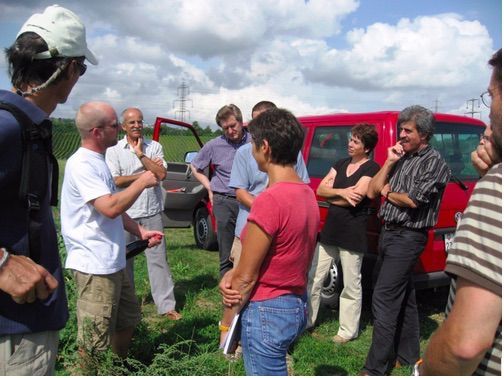Multi-stakeholder discussion group in the field
Context & initial phase
This method was developed during the first “From Farmer to Farmer” project related to sustainable soil use in Switzerland (2001-2005). The core question then was how to organise a meeting where such diverse stakeholders like soil scientists, experts from federal and cantonal administration and farmers could exchange knowledge on equal footing. Because the gap between their views, languages, interests and methods is huge, the question arose how to bridge this gap? The answer was: Start without a table. We met in the working context of the target group i.e. where a farmer demonstrated No tillage farming on his field. This enabled him to express his views and transformation knowledge with respect to soil protection in a meaningful way. Meeting in the field allowed everybody to get to know each other and exchange knowledge in an informal setting.

Effects on organizational and social learning
An accompanying study revealed that this method with its face-to-face-based learning processes enabled organisational learning by “establishing links in a ‘boundary space’ trying out new forms of collaboration and aiming at social learning and co-production of knowledge” (Schneider et al. 2009). A representative of the Swiss federal office for environment FOEN realised, for instance, that their way of addressing farmers was only partial, meaning they neglected the economic and practical implementation of soil protection and left these aspects to the farmers. The authors showed that the main characteristics for shaping spaces for social learning were collaborating beyond traditional political tensions, creating an atmosphere of trust that leads to acknowledgement of farmers’, experts’ and scientists’ views and knowledge, communicating and interacting beyond the knowledge systems to which actors belong and creating possibilities for sharing tacit and explicit knowledge.
Strategies for social learning:
Following strategies were used to shape these spaces for social learning:
(Schneider al. 2009)
- Allowing actors with different perspectives and interests to have access to the process
- Looking for intermediary persons
- Allowing participants to be part of the process
- Actively integrating new participants
- Clarifying roles
- Establishing personal relations
- Informal meetings
- Bilateral meetings
- Meetings at the participants’ locations
- Commitment, engagement and sensitivity of a facilitator
- Long-term process
- Seeking common interests and liaisons
- Collaboration on specific product, goal orientation
- Organising situations where distinct actors are addressed as “experts”
- Placing personal experiences at the centre of collaboration and not scientific results
- Reflecting on the participants’ distinct perspectives and knowledge
- Enabling novel and positive experiences
- Building on previous learning processes
- Intermediary objects (e.g. videos)
- Using story telling methods
This method was used in several “Social learning video”-projects:
- From Farmer to Farmer series: ‘Organic Agriculture in the Mountains has a Future’ 2013, ‘Successful Grazing Management and Pasture Maintenance in the Swiss Alps’ 2013, ‘Successful regional marketing’ 2018, ‘strategies in plant protection’ 2019-2021
- ‘Hidden functions of Alpine soils’ 2016
- Pilot programme climate adaptation. Strategies for flood protection - Three new films 2019-2021
This method was used as well for teaching td skills for Co-producing knowledge:
- ETH Winter School ‘Science meets Practice’ 2011 - 2020
- University of Bern, Seminar ‘Mobilität und nachhaltige Entwicklung’ mit ‘Social Learning Video’ 2019 – 2020
References

